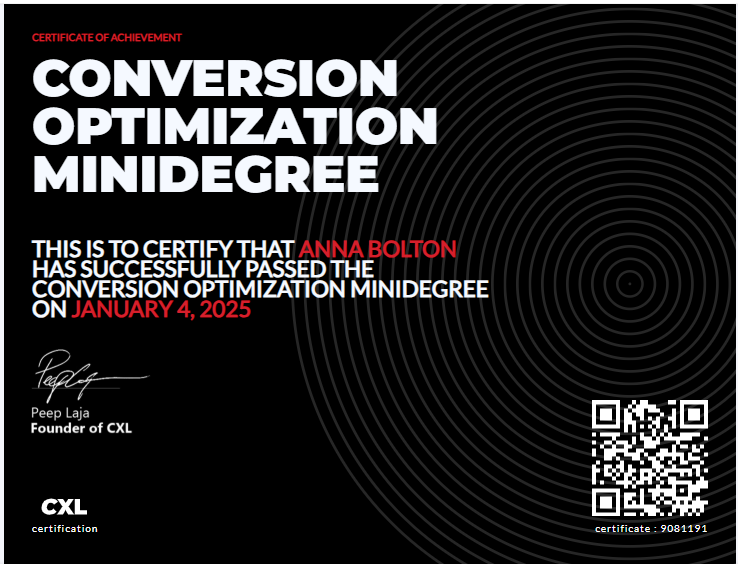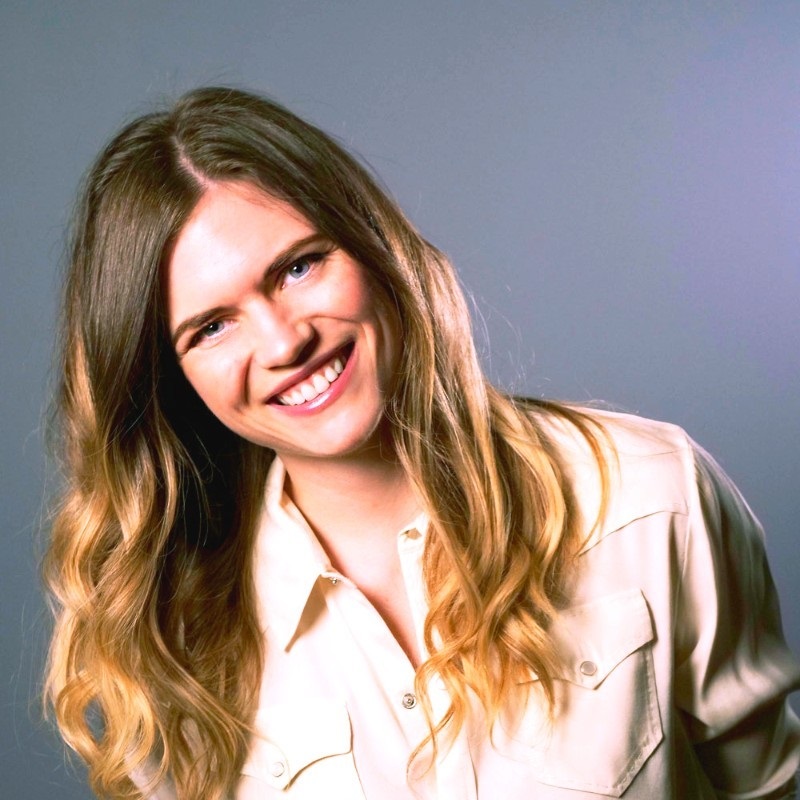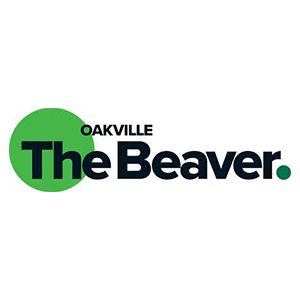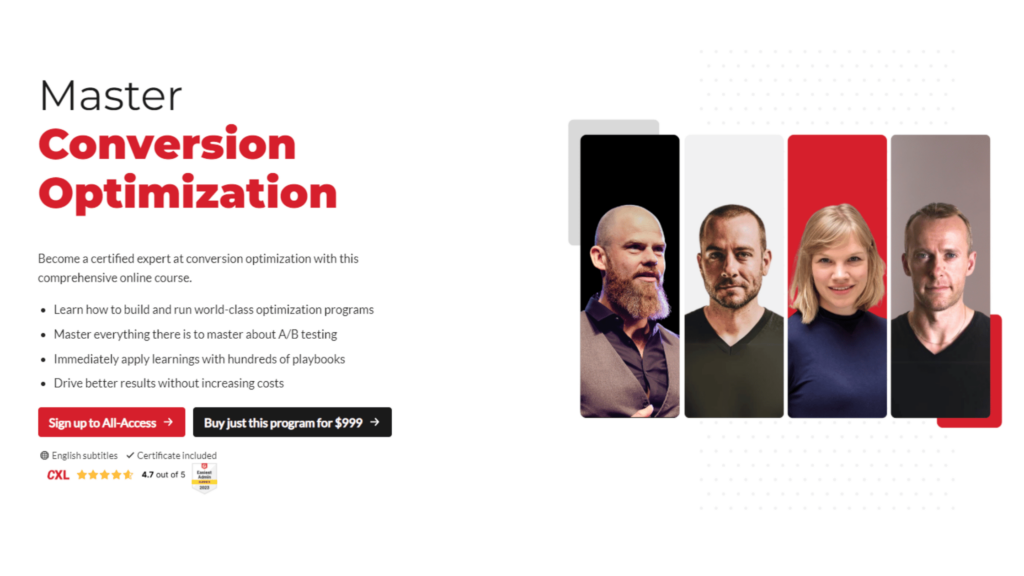
If you’re in the market for conversion rate optimization (CRO) training, chances are you’ve considered the CXL certificate program.
Getting certified in CRO by the world-class CXL Institute could be a strategic move for your career or consulting practice. However, there is a cost and a significant time investment.
In this post, I’ll share what I think about this program and highlights from what I learned in each course.
What is conversion rate optimization?
You probably already know the answer, but in case you stumbled on this post…
“Conversion optimization is a systematic way to convert browsers into action takers (leads, buyers). It’s about making more money and growing the business without investing additional resources into acquisition.” – CXL, Conversion Optimization
Conversion rate optimization can be applied anywhere people find a business online: ads, unpaid content, emails, core webpages, purpose-built landing pages, check-out flows… anywhere.
Why get certified in conversion rate optimization?
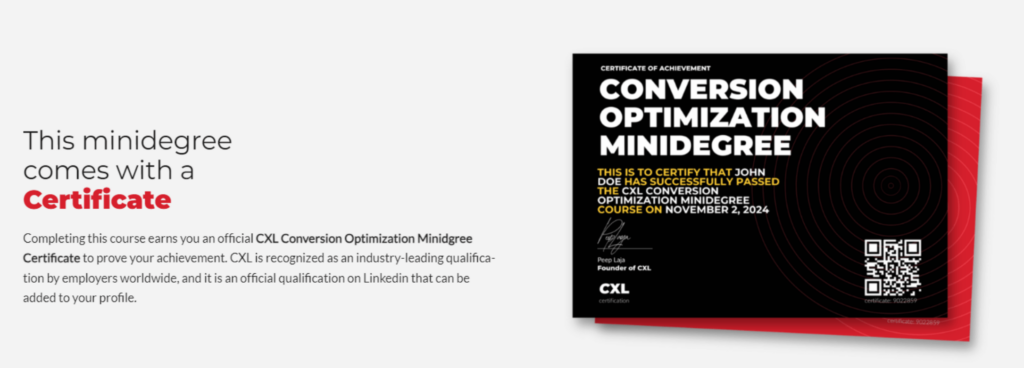
CRO training is valuable in itself for any marketer, certification aside. Just knowing this stuff is essential.
Why should you get certified?
If you’re simply looking to learn CRO strategies and techniques to grow your own business, you don’t really need certification. Just take the training that’s relevant to your goals and challenges.
You may want CRO certification if you’re a consultant, like me, or to advance your career inside a marketing department, for example.
I don’t pretend to have a crystal ball, but I believe that CRO certification will be even more valuable in the future for consultants and professionals. There’s simply more competition in every viable sector, which means that marketing needs to be much smarter. CRO is a data-driven path to earning those small edges while avoiding wasteful efforts. Demand for CRO expertise should grow.
Can’t software do conversion optimization?
Not yet. Machine intelligence will streamline a lot of marketing labor. Conversion optimization is a higher order of consulting and, IMO, will remain valuable.
Who should get certified as a CRO?
In my experience, most people come to CRO from a digital marketing specialization. Usually, paid traffic, website design/UX design, marketing research, data analysis, or even behavioral/marketing psychology.
CRO encompasses these disciplines; you need to understand these specializations to do CRO, but CRO focuses these disciplines on the business goal of generating more conversions.
If you’ve been working as a specialist in one of these more niche fields and you’re ready to play a bigger role, I’d say CRO certification is right for you.
Why I decided to get certified in Conversion Optimization
It was high time! I’ve been a certified conversion copywriter since around 2018 and actively advising clients on CRO.
In 2024, I realized that getting certified in conversion rate optimization is the natural next step. CXL certification is the proof to back up what I already know and the training I need to fill the remaining gaps.
I want my clients to understand that I’m not just an expert in messaging and sales psychology; I’m a conversion strategist and expert in marketing experimentation.
About CXL’s Conversion Rate Optimization training
To be honest, CXL certification is the only CRO training I considered. I’ve been in this industry for a while and have never heard of a program that compares.
What’s involved?
CXL certification in conversion rate optimization is earned by completing 22 courses and passing a final exam. Note that CXL updates the program periodically, so this could change.
It’s called a “minidegree” program, which I don’t love. Anything with “mini” sounds a bit too cute and doesn’t reflect the seriousness of this course.
Program pricing:
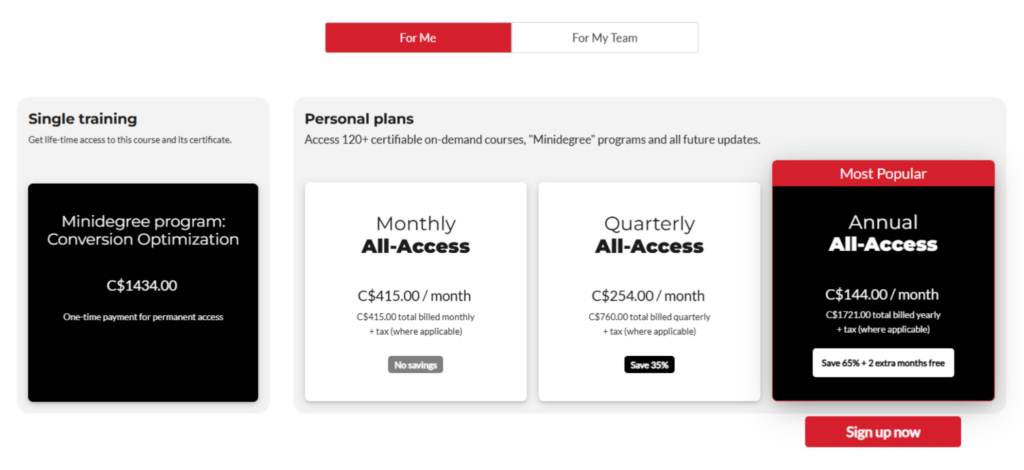
CXL practices what they preach — they test! Their pricing page is no exception. Since I signed up, CXL has introduced two new pricing options. Above are the current prices in Canadian dollars at the time of writing.
You can now access the CRO certification training by paying a flat rate for the entire CXL training program.
Just a few months ago, this program was only available via an all-access CXL Institute pass, monthly or yearly. CXL has recently introduced a new quarterly all-access pass as well.
Compared to other programs and given that CXL is widely recognized, I think this is excellent value.
I chose to pay monthly as an incentive to focus and complete the degree faster. If I had all of the pricing options now available and knew for sure that I could complete it in three months, I’d choose the flat rate or quarterly pass.
Hours/time investment:
You’ll work at your own pace, so you can set your own completion goal. However, these are not light courses. The duration of each course in the CRO certification program ranges from 1 to 11 hours.
I would estimate that there are about 100 total hours of video training in this program, plus a number of course exams, exercises, and a final exam. The pass rate is 90%, so you can’t wing it.
Consider setting aside at least 120 hours to complete the program. Longer if you want to apply what you’ve learned immediately, which is always a good practice.
I set out to get certified in three months, from October 2024 to January 2025, which meant studying more than an hour a day on average. I had a slight head start because I’d done a handful of the courses years ago.
Difficulty:
This program tends to be more complex and academic than other training. Sometimes unnecessarily so.
I’ve already taken a lot of training in sub-fields of CRO, including research, psychology, running an agency, conversion strategy, heuristic analysis, copywriting, and even program management/organizational development. The CXL courses covering these topics felt more like review or a different lens on familiar subject matter.
However, I came in with a very rusty recollection of statistics from university. A significant number of the courses are heavy on stats. You’ll have an advantage if you’ve been using statistical analysis in your career regularly.
I want to compare this to a reference to give you a sense of the difficulty. Years ago, I earned a Project Management Professional (PMP) designation from PMI. If I were to compare this CXL program with the PMP, I’d say the volume of content is similar, but the PMP exam is much longer.
How I tackled the Conversion Optimization Minidegree
As mentioned, there are 22 courses in the CXL Conversion Optimization Minidegree program, plus an exam.
These courses aren’t designed to be taken in a strict order, but CXL roughly suggests a path.
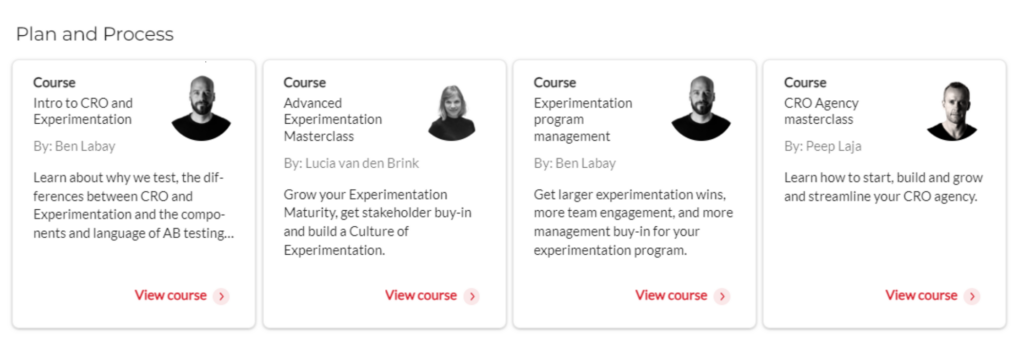
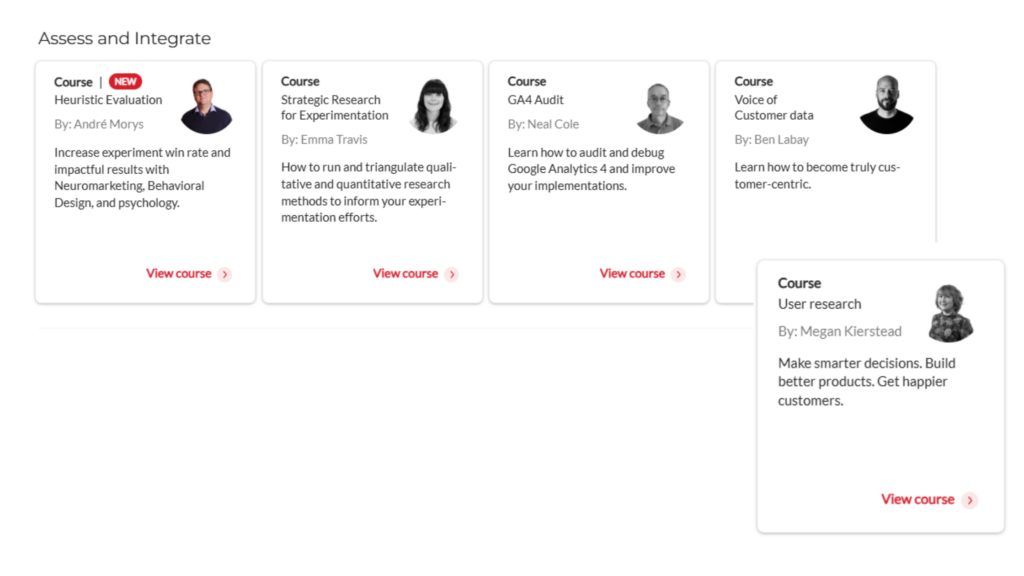

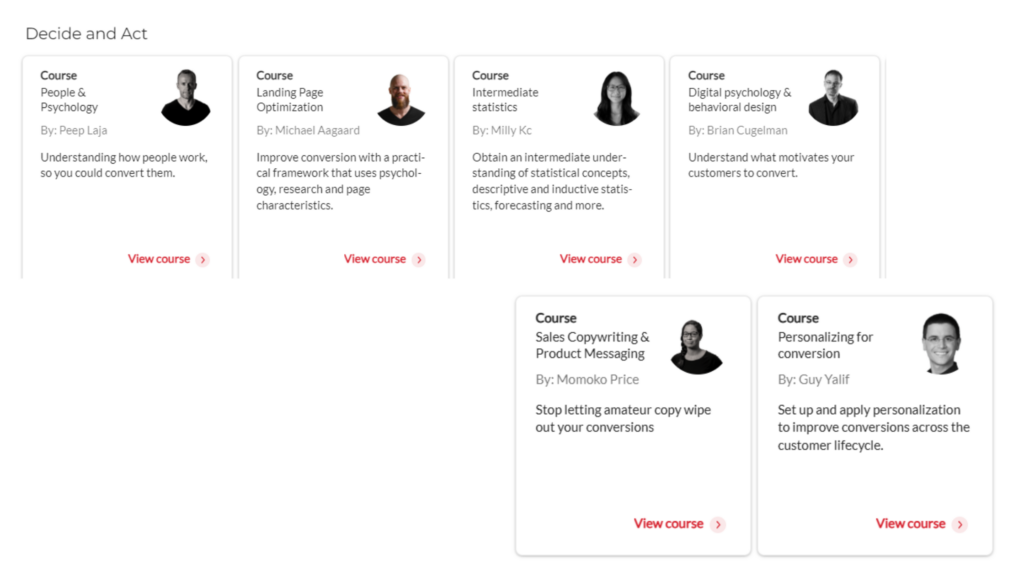
I did not follow the recommended path for a few reasons.
- I quickly realized there was no absolute reason to do so. The courses don’t necessarily build on each other. There are no prerequisites.
- I’d already taken some of the required courses in 2022 when dipping into the CXL library.
- I wanted to fit the course into my life and workload. So, I frontloaded the topics I felt comfortable with already. Then I completed the more technical and challenging courses (analytics and statistical analysis) around the December holidays.
How I’d rate the CXL Conversion Optimization Minidegree overall
I have no end of respect for Peep Laja and his team. In my view, this course fills a gap in what few others could credibly teach.
I’d also note that CXL teaches with great seriousness. There is no fluff here. It’s dense with behavioral science, research methods, experimentation design, and business best practices honed through years of running a conversion rate optimization agency.
I also appreciate that CXL educators appear to have an ethical compass. They steer clear of dark patterns, both in converting buyers and dealing with clients.
CXL is also very thorough. This is a comprehensive dive into the essential knowledge areas of a CRO consultant.
Finally, the production quality is excellent. Great lighting, video editing, and, for the most part, excellent visual design (clean slides, etc.) and audio.
The areas for improvement?
1. Program design:
The CRO minidegree program doesn’t feel like a unified curriculum. It feels like a collection of related training without a clear path, say, from beginner to expert.
It reminds me of a house with extensions added over time, using different materials. You feel, at times, like you’re in an older section of the house and then find yourself in a new wing. The elaborate and complex butts up against the minimalist.
Some areas of emphasis seem disproportionately heavy, while others are seemingly given short shrift. Intro courses are sometimes followed by advanced masterclasses, with nothing to bridge the two.
To extend the house analogy, a program without an instructional designer is like a house without an architect. Even if the individual parts are cool, the overall effect can be disorienting.
2. Theory of mind:
Pretty sure this is not a term from adult education/instructional design, but it’s definitely related to conversion optimization.
I was sometimes left wondering, what is CXL’s theory of the learner before and after this program? Do they know who this learner is when they start the course? Do they understand the journey?
Some of the individual instructors seem to have a learner persona in mind. Others seem to forget the learner; they’re trapped in their expertise.
Again, this comes down to instructional design. Someone needs to be the director or architect behind the program (and that someone needs to do their user research).
3. Quality control:
Courses do not have to be perfect–and as mentioned, CXL delivers excellent quality visuals. There are, however, some gaps in the quality of this program.
Big picture, the quality of the instructors is mixed. Some instructors seem born to teach, and others seem born to research. Enough said!
I’d also note that some course text could use a good edit. The transcripts are machine-generated and uncorrected, making it tough to check what an instructor has said when their accent obscures the meaning. Likewise, the course exam questions have some errors that could easily be fixed.
Again, an instructional designer could fix these issues, which matter but don’t detract from the overall value of the program.
🌟🌟🌟🌟
I’d give the CXL Conversion Optimization Minidegree a solid four stars.
Overall, even the flaws remind me of university. You pull together pieces and hope the total makes an education. Sometimes, you get a star professor who changes your life. Other times, you get a lecturer who could make a chalkboard weep.
I would rather CXL deliver rigorous training that’s a little dry than training that’s diluted. In a dream world, CXL would maintain that high level of rigor while integrating more adult learning principles.
COURSES IN THE CRO CERTIFICATION PROGRAM
These are the courses in the CXL Conversion Optimization Minidegree in the suggested order. Where there are ungated/public landing pages for a course, I’ve linked to that page so you can view more.
For each course, I’ve highlighted a key insight, plus what it means for companies in our niche and how to apply. Keep in mind that we primarily work with mid-sized B2C/DTC e-commerce brands (~ US $15M/year in revenue) that outsource their conversion copy.
INTRO TO CRO AND EXPERIMENTATION
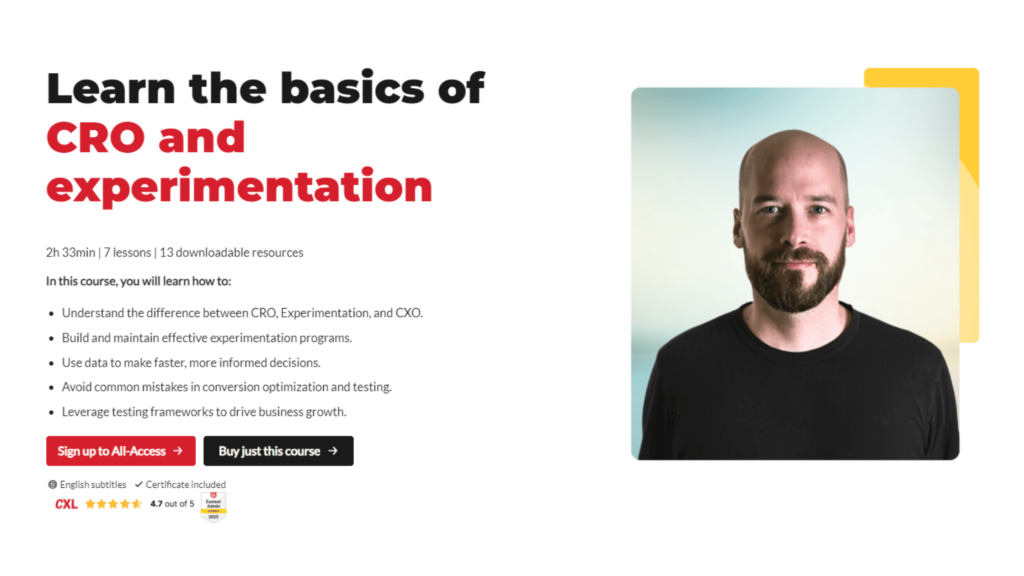
A comprehensive intro to CRO and marketing experimentation.
Key Insight: Many brands make costly mistakes by launching major website redesigns without data and testing. Revenue can drop after a redesign and if it’s a complete overhaul, you may never know why.
Application for B2C/DTC Brands:
- Implement incremental, test-driven changes to key website elements (e.g., homepage layout, product pages, checkout flow) rather than executing full redesigns without validation
- Use A/B testing to evaluate new features or designs before rolling them out sitewide
- Focus on rapid learning cycles to adapt quickly and minimize risk
Why It Matters:
Small to mid-sized brands can’t afford redesign failures that erode customer trust or lead to significant revenue dips. Experimentation ensures that investments in design and UX improvements generate measurable ROI.
ADVANCED EXPERIMENTATION MASTERCLASS
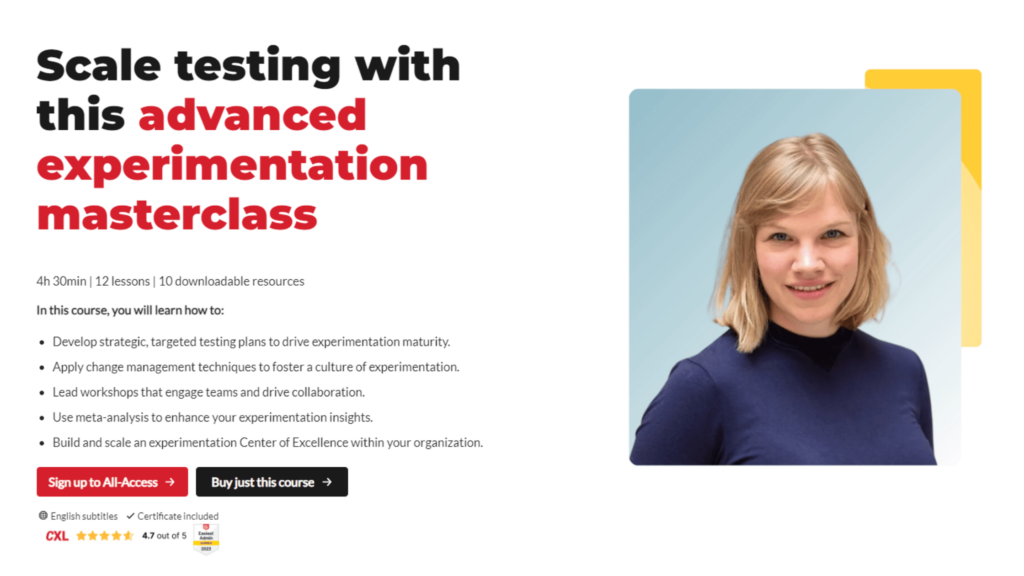
This masterclass is for anyone working to mature CRO in an organization. It explores ideation, hypothesis creation, app testing, and experimentation maturity audits. It emphasizes moving from random “spaghetti” testing to systematic, high-impact testing.
Gotta admit, it is intense to jump from an intro to CRO to an Advanced Experimentation Masterclass, but that’s how CXL chose to roll here.
On the plus side, the primary instructor (Lucia van den Brink) is excellent. She’s concise, expert, and engaging.
Key Insight: Use data triangulation (e.g., analytics, usability studies, surveys) and prioritization frameworks to focus on high-impact areas like cart abandonment or product discovery.
Application for B2C/DTC Brands:
- Leverage tools like heatmaps and surveys to identify friction points in the checkout process.
- Prioritize experiments that address key metrics like conversion rates, average order value (AOV), or customer lifetime value (CLV).
Why It Matters: Strategic testing ensures resources are allocated effectively, delivering measurable improvements in revenue and customer satisfaction.
EXPERIMENTATION PROGRAM MANAGEMENT
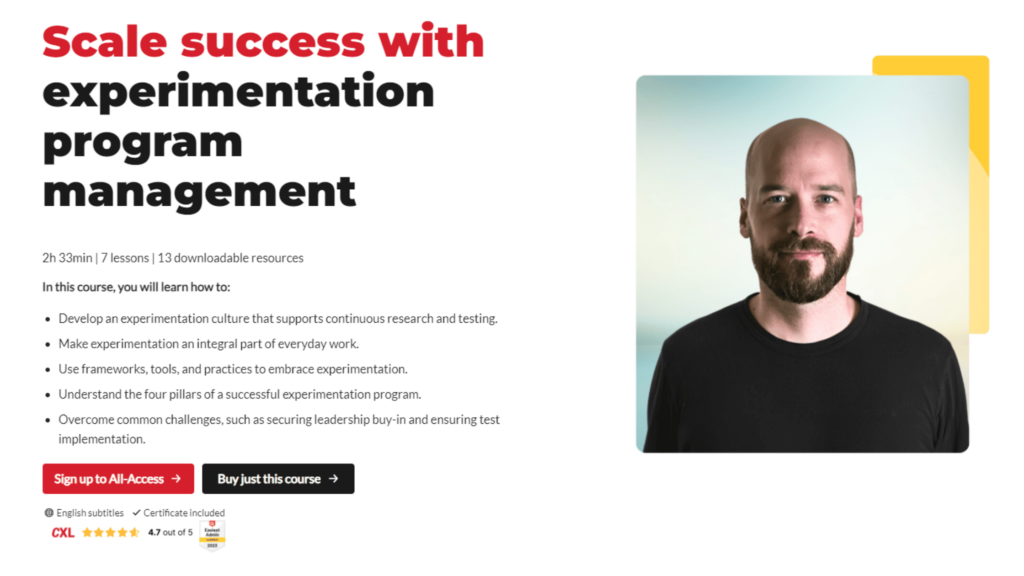
This course builds on the intro class and complements the masterclass, above. It’s for anyone who wants to scale up CRO and manage it as a program. If you’re familiar with program management and organizational effectiveness management theories, this will be familiar terrain.
Key Insight: Frameworks for evaluating experiment ideas help with prioritization and decision-making, so you can focus on experiments with the highest potential ROI.
Application for B2C/DTC Brands:
- Rank test ideas based on their potential revenue impact, feasibility, and available resources.
- Focus on high-value areas like increasing average order value (AOV) or reducing cart abandonment.
Why It Matters: Prioritization ensures that limited resources are allocated to experiments with the greatest business impact, delivering measurable results more quickly.
CRO AGENCY MASTERCLASS

This course is for anyone who wants to sell CRO consulting services. I enjoy Peep’s instructional style — concise, practical and engaging.
Key Insight: Not all CRO agencies are a good fit for every business. Agencies typically work best with companies generating over $10M/year in revenue and 1,000+ monthly transactions.
Application for B2C/DTC Brands:
- Evaluate your readiness for CRO partnerships by assessing your transaction volume, traffic and your budget for experimentation.
- If you’re a smaller business, focus on CRO services like conversion research or heuristic analysis rather than A/B testing-heavy programs.
Why It Matters: CRO is resource-intensive and designed to optimize scale. Partnering with a CRO agency prematurely can lead to underwhelming ROI.
HEURISTIC EVALUATION
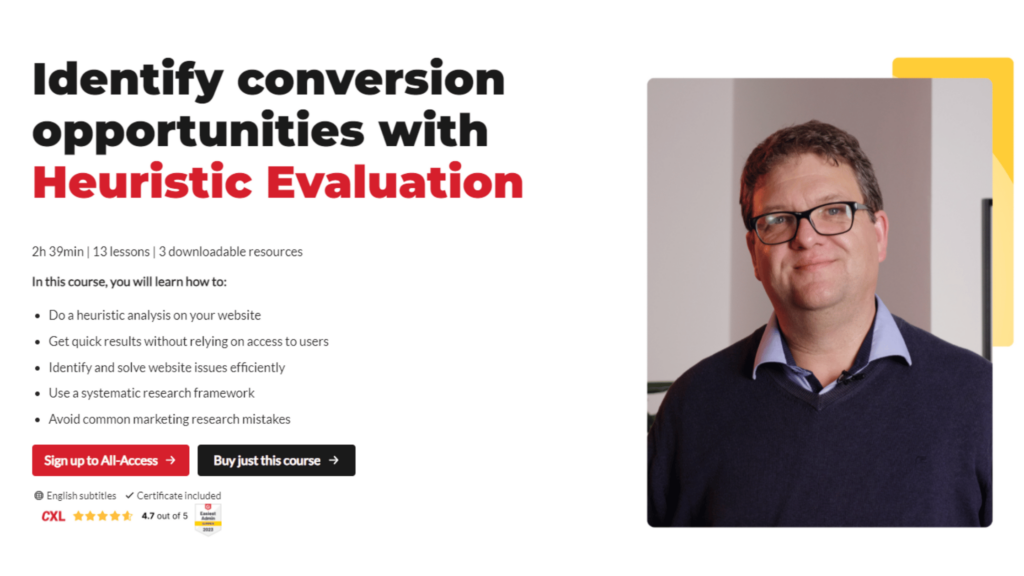
Heuristic evaluation is a systematic method for analyzing digital experiences to identify areas for optimization. It’s sometimes called an “audit” (like the copy audit service that we provide). Even though we’ve been doing this for a while, I thoroughly enjoyed this course because of the instructor and his excellent framework.
Key Insight: Heuristic evaluation identifies usability and conversion barriers, prioritizing high-impact areas for A/B testing while reducing random, ineffective experiments.
Application for B2C/DTC Brands:
- Conduct heuristic evaluations to uncover friction points using behavioral data (e.g., heatmaps, bounce rates) and customer personas.
- Provide CRO teams with access to traffic sources, personas, performance metrics, and competitor benchmarks for actionable insights.
Why It Matters: Prioritizing opportunities helps your business focus resources on improvements with the highest potential ROI. Starting with a heuristic analysis gets you closer to clear hypotheses, which can streamline testing. Efficiency bonus!
STRATEGIC RESEARCH FOR EXPERIMENTATION
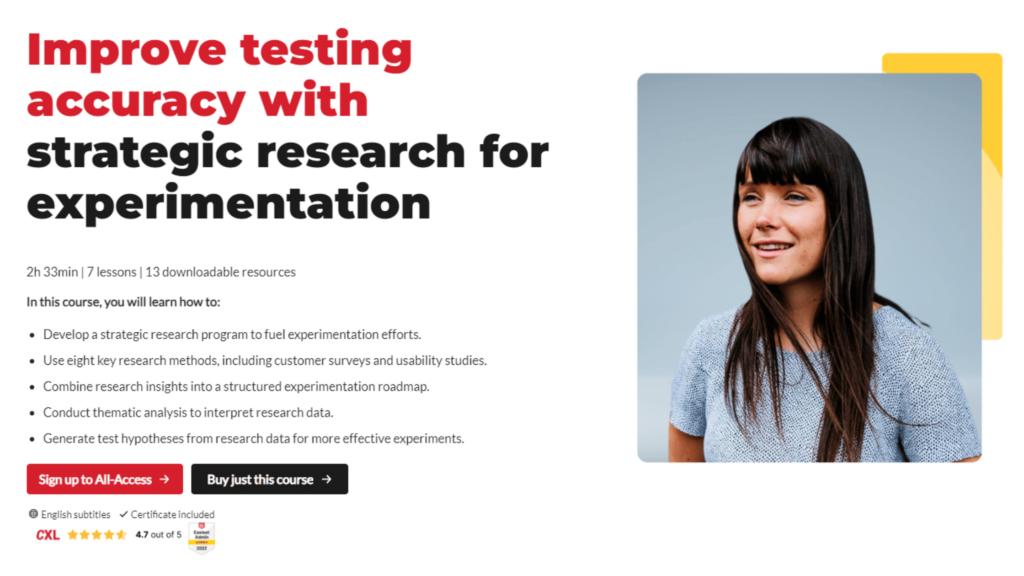
This was another 5/5 course for me — one of the standout courses in the CXL training program, largely because of the instructor’s clarity and organization.
Key Insight: Strategic research identifies user needs, motivations, and barriers, guiding targeted and impactful CRO efforts.
Application for B2C/DTC Brands:
- Use exploratory research (e.g., heatmaps, surveys) to uncover friction points
- Use focused research (e.g., behavioral analytics) to develop actionable hypotheses
- Use validation research (e.g., A/B testing) to confirm solutions before implementation
Why It Matters: Research helps your business direct resources to real issues, improve customer experience, and align optimization strategies with business goals to drive measurable growth.
GA4 AUDIT
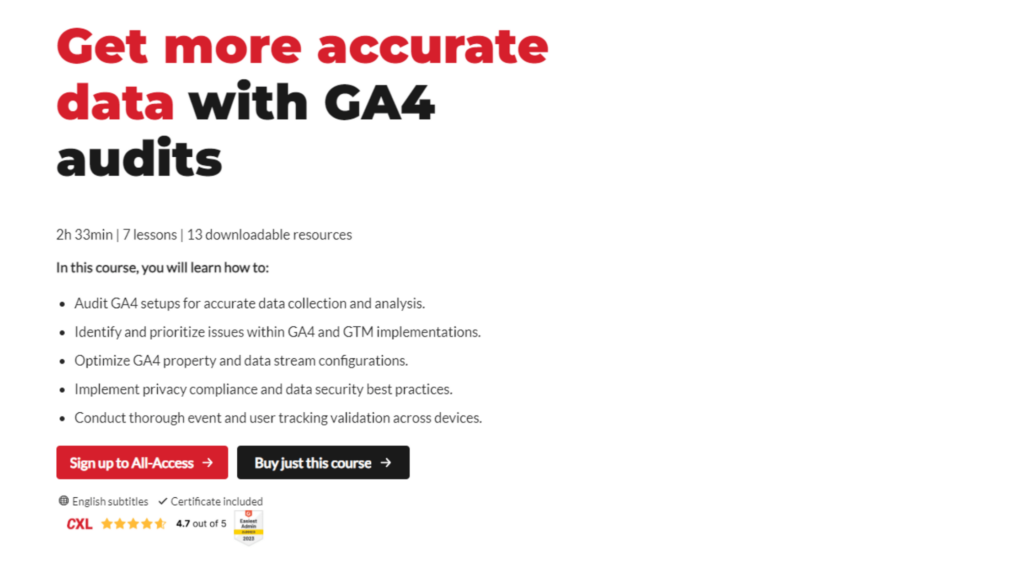
GA4 isn’t new, but many of the advanced techniques in this course likely are new for many marketers. I’m glad to have taken the course but it’s not something I’d execute myself as a strategist — this is for professional data analysts.
From the 5+ hours of training, here’s one insight that your competitors might not even be considering.
Key Insight: Custom events in GA4 allow marketers to track micro-interactions, such as hover patterns, wishlist additions, or specific button clicks, which are often overlooked by default tracking.
Application for B2C/DTC Brands: Use custom events to uncover pre-purchase behaviors and identify hesitation points in the buyer’s journey. These insights can guide targeted interventions, such as retargeting ads, personalized email campaigns, or enhanced product page designs.
Why It Matters: Subtle interactions can suggest a lot about user intent. With this level of granularity, you can make precise optimizations to improve conversions, user experience and loyalty.
VOICE OF CUSTOMER DATA
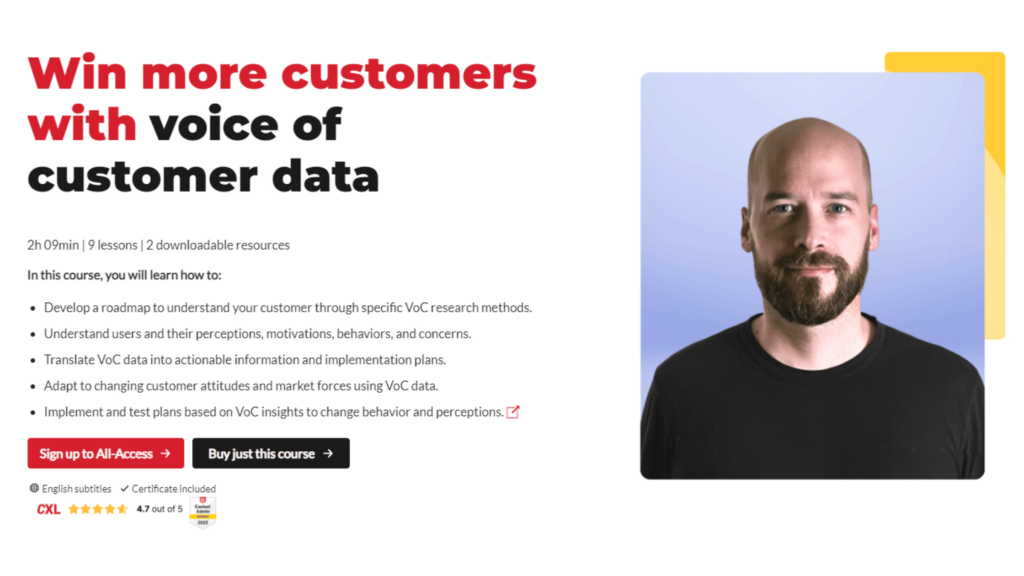
This course on voice of customer (VOC) research somewhat overlaps with the above Strategic Research for Experimentation. Both courses share foundational research methodologies and focus on using user feedback to inform experimentation and CRO. There’s some repetition on topics like survey design, data coding, and thematic analysis.
Key Insight: VOC data bridges the gap between analytics and empathy, ensuring CRO efforts are grounded in real customer experiences.
Application for B2C/DTC Brands:
- Gather VOC data through surveys, reviews, support tickets, and on-site polls to identify recurring pain points, anxieties, and motivations.
- Use these insights to refine messaging, prioritize optimizations, and inform A/B testing strategies.
- Segment feedback by user personas or buyer journeys for targeted improvements (e.g., cart abandonment or first-time buyer experiences).
Why It Matters: VoC reveals user needs and friction points so you can craft smarter hypotheses. This leads to more effective optimizations, better UX and improved marketing performance.
USER RESEARCH
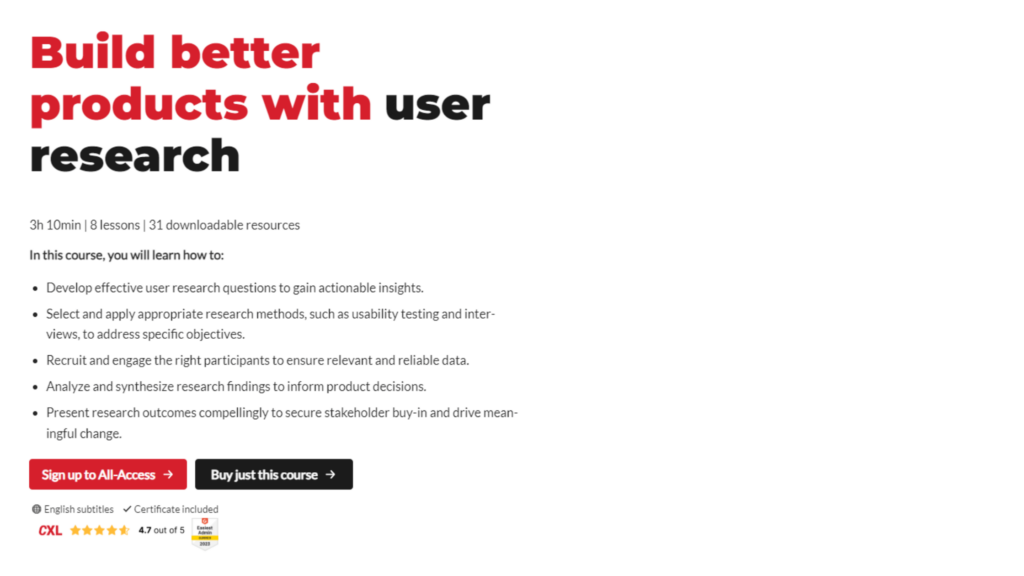
After two heavy courses on research, I did wonder whether this User Research course is a truly necessary component of CRO certification. Especially because this type of research focuses on solving user problems vs. marketing problems.
That said, it does introduce some new lessons, and classic user research can inform CRO.
Key Insight: User research identifies unmet needs, frustrations, and desires, providing actionable insights for optimizing products, offers, and messaging.
Application for B2C/DTC Brands:
- Conduct interviews or surveys with existing customers to uncover their feelings and beliefs about your products or buying process.
- Use insights to improve product features, design new bundles, or refine promotional strategies.
Why It Matters: Understanding customer pain points helps develop better-targeted offers, reduce friction, and improve product-market fit, driving conversions and retention.
A/B TESTING FOUNDATIONS
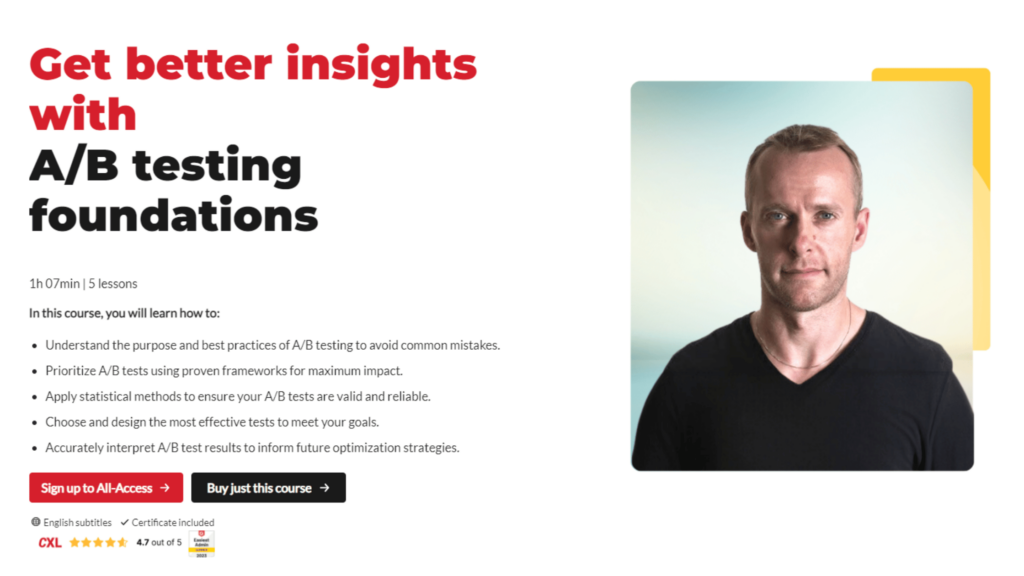
This is a very concise, practical, and well-structured intro to A/B testing. Peep focuses on business impact and keeps the science accessible.
Key Insight: For pages with 1,000 conversions or more per month, A/B testing is a powerful validation tool. For pages with less traffic, focus on heuristic analysis, usability improvements, or qualitative research instead.
Application for B2C/DTC Brands:
- Use data-driven insights to prioritize tests on high-impact areas like product pages, checkout flows, or subscription offers.
- Leverage pre-test sample size calculators to confirm the feasibility of testing and avoid invalid results.
Why It Matters: When you use the right CRO tools for the right scenarios, you can make better use of resources, confidently steer your optimization program and get more consistent improvements across your KPIs.
CRO FOR ECOMMERCE GROWTH
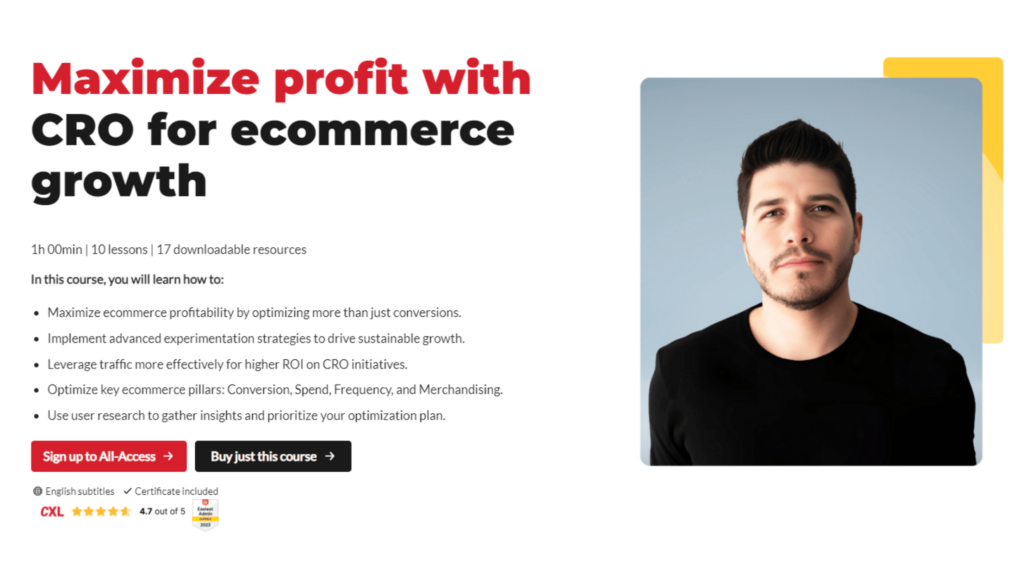
This is a useful and concise intro to CRO for e-commerce. It covers how CRO applies to e-commerce, practical strategies, common pitfalls and more. I particularly enjoyed the lesson on optimization applied to merchandising.
Key Insight: For e-commerce, composite KPIs like CLTV and ARPV are more important than simply tracking conversions. It’s essential to analyze and optimize strategically and systematically across the customer journey.
Application for B2C/DTC Brands:
- Align experimentation with strategic goals
- Prioritize high-impact optimizations,
- Focus on reliable data and user behavior insights
- Systematically test across all touchpoints
Why It Matters: Done right, CRO experimentation can transform the e-commerce customer journey and drive growth by improving conversions, AOV, retention, and profitability.
STATISTICS FOR A/B TESTING
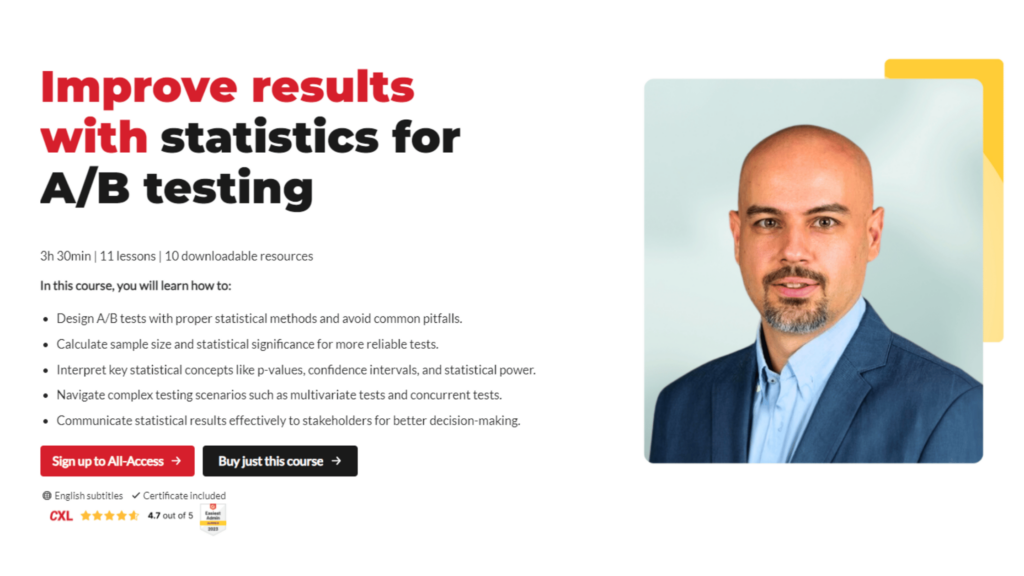
Not an exciting course, but very credible and comprehensive.
Key Insight: A/B testing is a tool for managing risk while fostering innovation through data-driven decisions. (It’s not just about finding winners!)
Application for B2C/DTC Brands:
- Use A/B testing to implement changes that balance customer experience and revenue growth
- Prioritize tests that align with strategic goals
Why It Matters: By approaching A/B testing as risk management, CMOs can make faster, informed decisions, optimize resource allocation, and cultivate a culture of data-driven experimentation.
A/B TESTING MASTERY
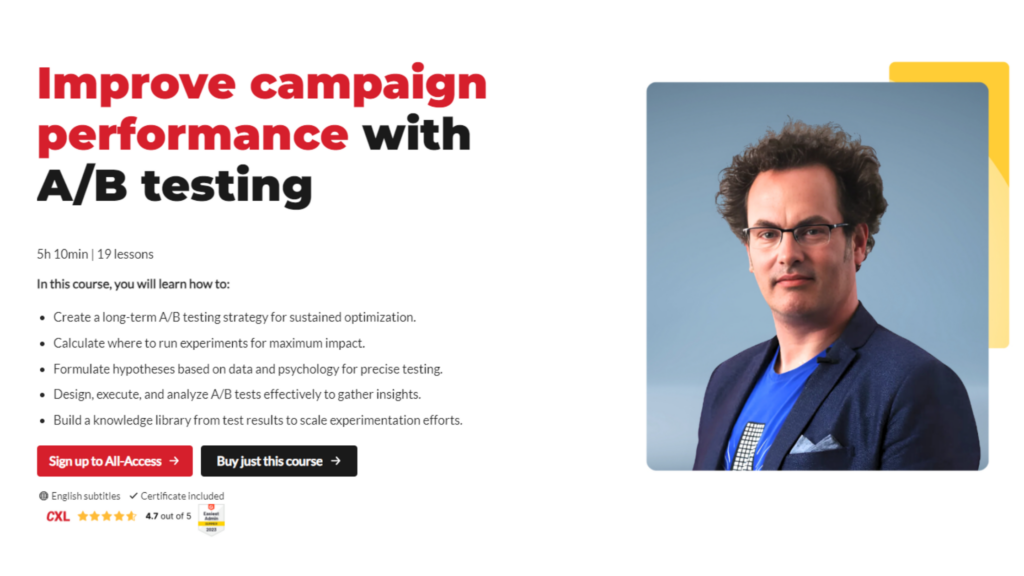
A/B Testing Mastery! So enticing. I wanted to love this, but it’s one of the courses that could use an overhaul. It’s difficult to get through but useful.
Key Insight: Effective A/B testing prioritizes customer-centric hypotheses, rigorous research, and high-impact experiments aligned with user behavior and business goals.
Application for B2C/DTC Brands:
- Leverage proven CRO models to identify conversion barriers
- Prioritize tests using tested frameworks
- Focus on high-traffic areas like product pages and checkout to yield significant results
Why It Matters: A disciplined, data-driven approach is the path to sustainable growth in a crowded market.
STATISTICS FUNDAMENTALS FOR TESTING
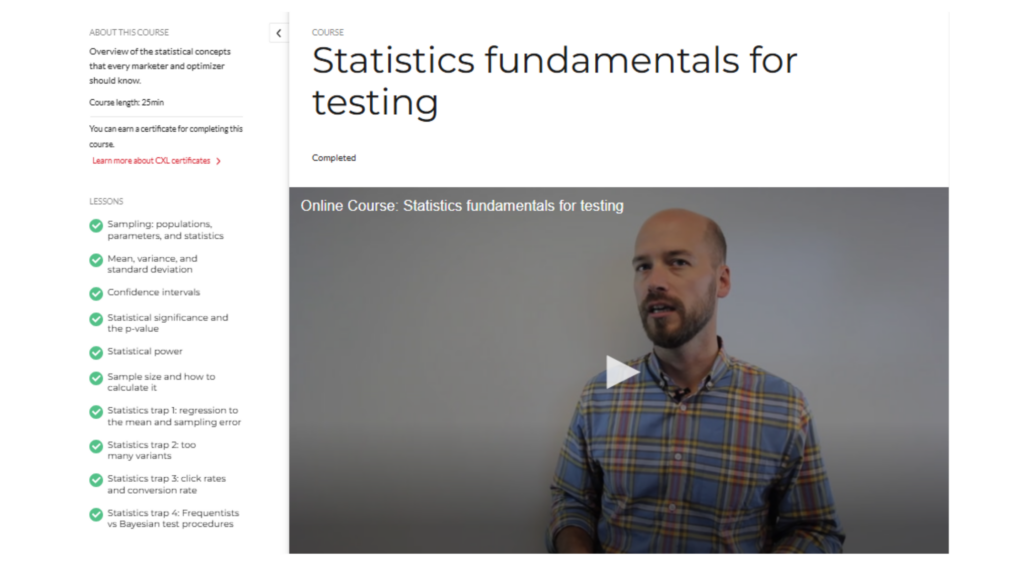
This course felt incredibly light at just 25 minutes. I’d recommend taking it before the other statistics courses as a warm-up. The “testing traps” were a useful frame, and I’ll share one here.
Key Insight: Running too many test variants increases the probability of false positives, dilutes trust in results and can lead to wasted resources.
Application for B2C/DTC Brands: Focus on 2-3 well-conceived variants with clear hypotheses. For example, if testing landing page designs, limit variations to major changes like layout or key messaging rather than minor tweaks like button colors.
Why It Matters: By testing fewer, high-impact variants, you’re more likely to get statistically valid and actionable findings.
TESTING STRATEGIES
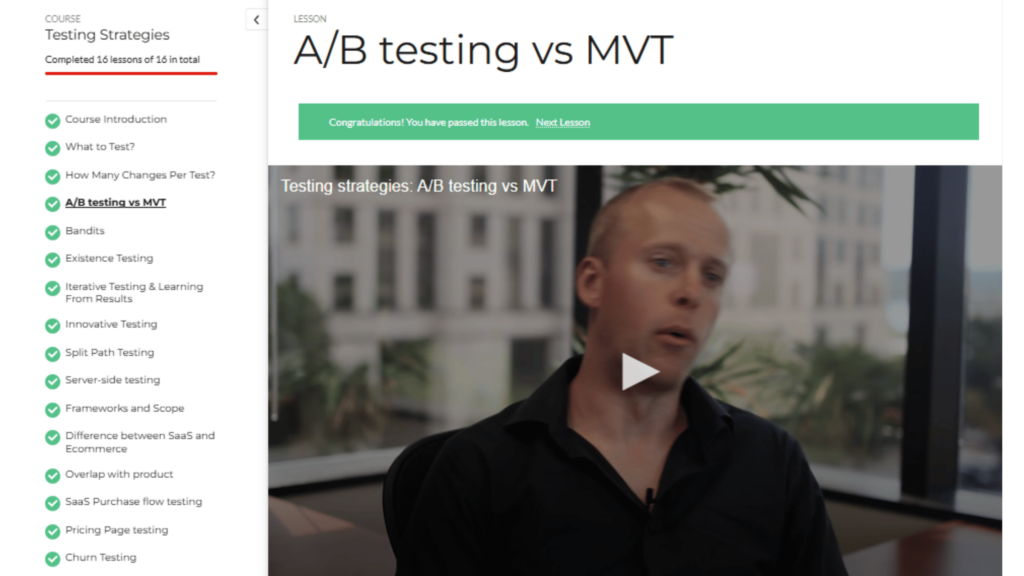
Being an expert at testing strategies is, I’d argue, the core skill of a CRO. Nearly everything else we can outsource or assign to niche specialists. That why I would have liked Peep to go into more depth in this course.
Key Insight: CROs needs to balance scientific rigor and business impact. Sometimes you need to make multiple changes to a variant to achieve a significant lift (even if that means sacrificing certainty regarding what changes caused the lift).
Application for B2C/DTC Brands: Rather than isolating single variables, group changes that address a shared hypothesis (e.g., clarity improvements) or fix identified problems (e.g. checkout friction).
Why It Matters: For B2C/DTC brands with limited traffic, bundled changes maximize the impact of each test for faster growth.
GOOD PRACTICES
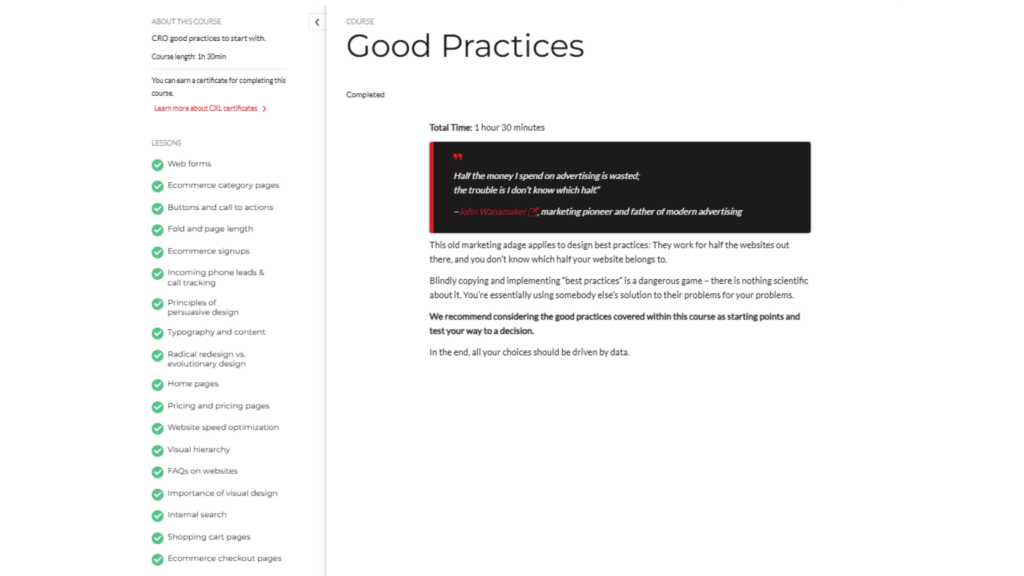
This is a primarily text-based course, which was refreshing. As the name suggests, these Good Practices are not revolutionary, especially for teams with some CRO sophistication. It’s a great overview, nevertheless, and includes some creative ideas that are worth testing. For example:
Key Insight: Try testing bold changes on underperforming or lower-traffic products to unlock hidden growth opportunities.
Application for B2C/DTC Brands: Optimize underperforming products by improving charity, specificity and perceived value. Try experimenting with creative design or merchandising strategies, like bundling.
Why It Matters: Focusing on underperforming products can drive incremental sales, boost overall cart value, and prevent stagnation across your catalog. This approach also diversifies revenue sources and strengthens your product mix.
PEOPLE & PSYCHOLOGY
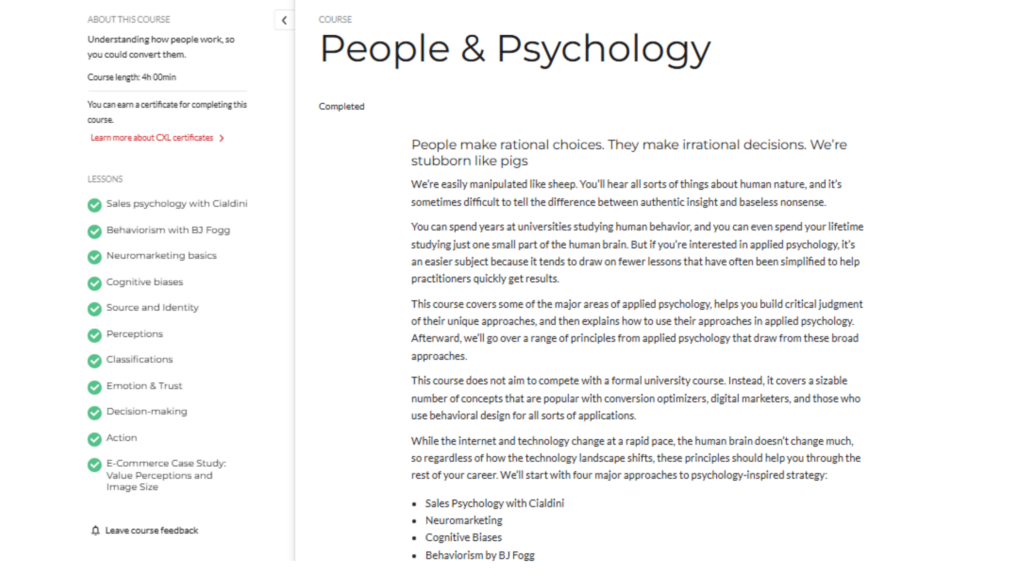
This course covers the classics of conversion psychology or sales psychology. Many are widely known to customers now, and CROs should keep that in mind. This isn’t the internet of the 90s anymore! It’s not even the internet of 2020. We need to think of new and creative ways to apply these findings.
Key Insight: As per the Endowment Effect, customers place a higher value on what they feel they own, even before purchase.
Application for B2C/DTC Brands: Free trials and samples work, in part, because of the Endowment Effect. Depending on your product, you could offer try-before-you-buy options, AR previews, or personalized product configurators. Use product selection quizzes to elicit the motivation behind a purchase, and use copy to affirm they’ve “made the right choice” before the purchase.
Why It Matters: Customers can be all too quick to back-click or abandon the cart. Rescue more of those conversions when you foster an early sense of ownership.
LANDING PAGE OPTIMIZATION
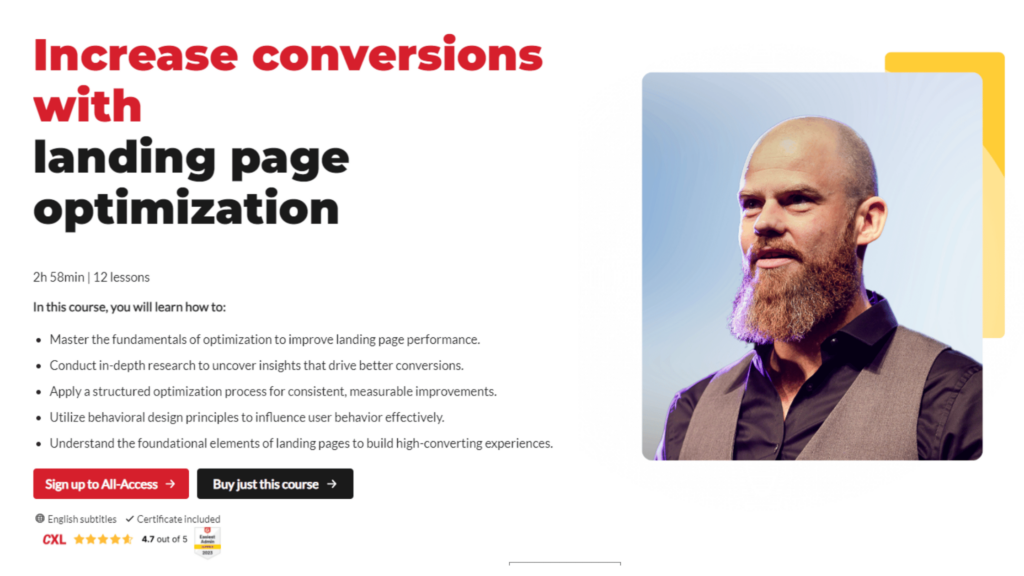
I’ve done a lot of training and work on landing page optimization, but I still thoroughly enjoyed this instructor’s teaching. He’s an award-winning speaker and it shows.
Key Insight: Users are more likely to convert when landing pages match their awareness level. E.g. Problem-aware visitors need to believe that a solution exists; solution-aware visitors need to understand why your solution is different and better.
Application for B2C/DTC Brands: Tailor landing page content based on traffic sources. Ads targeting new audiences and retargeting ads often need custom landing pages.
Why It Matters: Paid traffic is too pricey to throw away, yet misaligned messaging leads to friction and drop-offs.
INTERMEDIATE STATISTICS
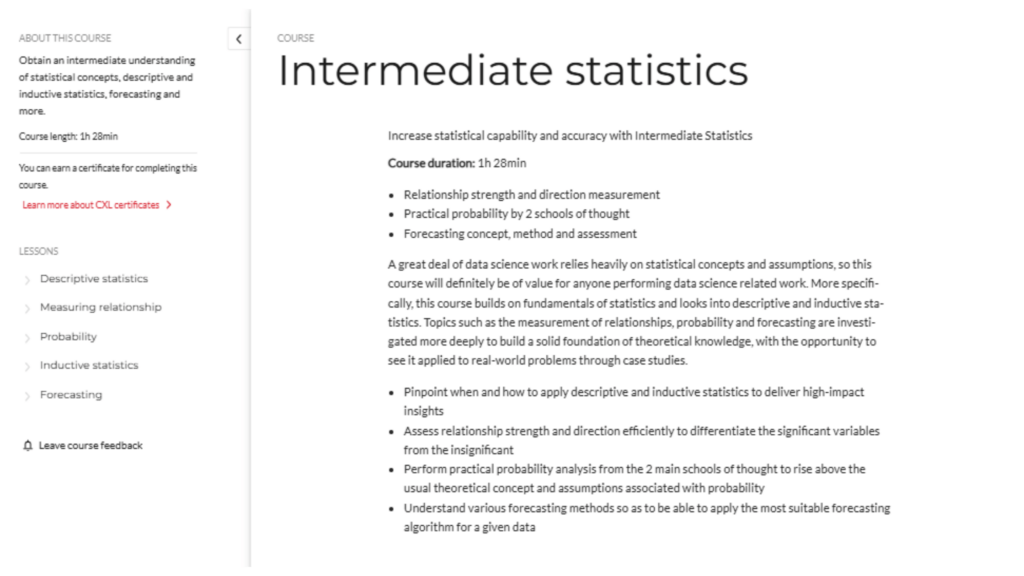
And we are back to statistics! There are overlaps between Intermediate Statistics and the others but this course does introduce new concepts, particularly around forecasting.
Key Insight: Forecasting future sales trends based on past data can help B2C/DTC e-commerce marketers plan for seasonal demand spikes and long-term growth.
Application for B2C/DTC Brands: An online skincare brand could analyze historical sales data to predict increased demand for sunscreen as spring approaches. By identifying patterns from previous years, they can prepare inventory and marketing campaigns to meet customer needs at the right time.
Why It Matters: Anticipating demand ensures products stay in stock during peak periods, avoiding lost sales and overstock.
DIGITAL PSYCHOLOGY & BEHAVIOR DESIGN
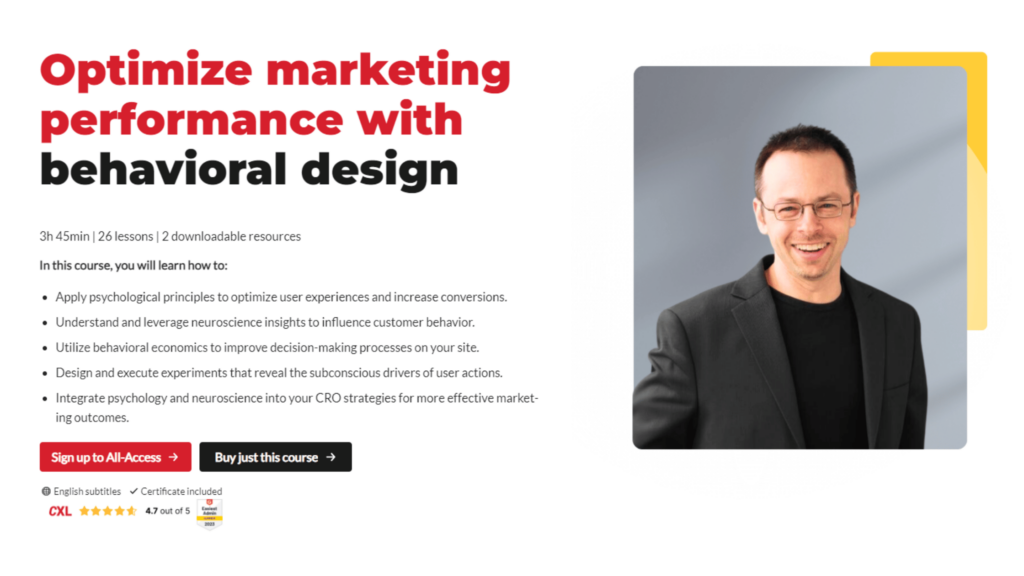
This course essentially expands on the People & Psychology course by Peep Laja. It’s useful to understand these principles, but important to remember that they’re just principles. Your mileage may vary.
Key Insight: Leverage emotions, habits, and navigation patterns to guide users to the next conversion.
Application for B2C/DTC Brands: Design customer journeys that simplify complex choices, tap into emotions that drive decisions and try replicating the familiarity of physical navigation in digital environments.
Why It Matters: Understanding how people behave online is a lot like understanding other humans IRL. It just makes you more persuasive.
SALES COPYWRITING & PRODUCT MESSAGING

Yes, this is another 5+ hour course… But it’s a remarkably concise guide to modern sales copywriting (aka conversion copywriting). Every e-commerce marketer should know these strategies and techniques, from the macro (value proposition) to the micro (how to strengthen calls to action).
Key Insight: A strong value proposition zeroes in on unique product benefits surfaced through voice-of-customer research.
Application for B2C/DTC Brands: Use customer feedback to identify key motivators and differentiators. For example, if customers praise your eco-conscious materials, craft a value proposition like: “The only sustainable yoga mat made from 100% natural rubber.” Test variations emphasizing quality, durability, or mission alignment.
Why It Matters: Value propositions based on authentic customer insights speak directly to what matters most to your audience.
PERSONALIZING FOR CONVERSIONS
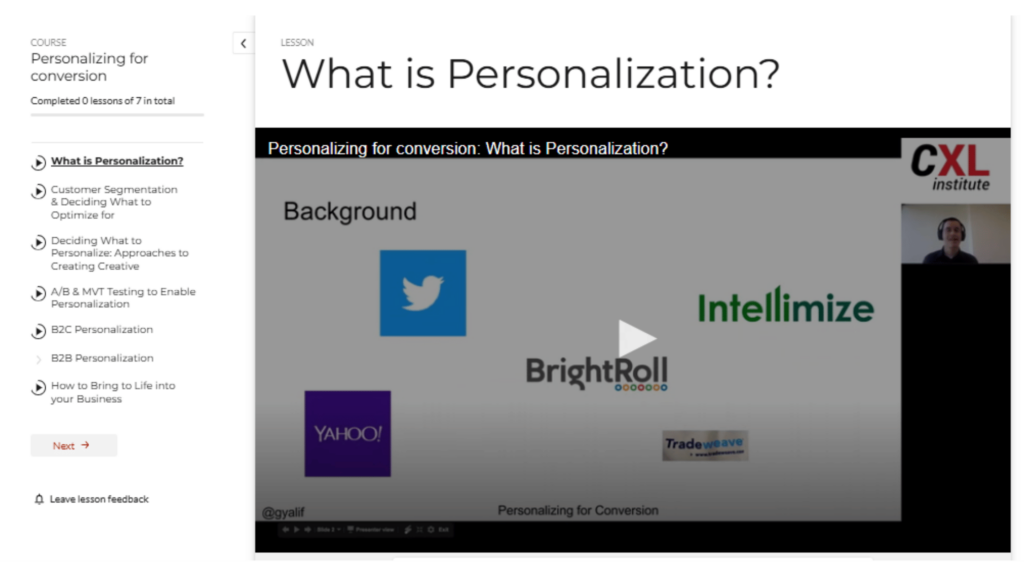
Quite possibly the most interesting course in the program. However, it is 11 hours long!
It is, as the name suggests, about using personalization and testing strategies to tailor experiences to different users.
For e-commerce, “(t)his is done by delivering relevant content, product recommendations, offers, shopping experiences, and support based on customer preferences, behavior, and demographics—these days, using first-party data. It aims to enhance customer satisfaction, engagement, and conversion rates by providing a personalized shopping journey.” – Ecommerce Personalization: Tactics and Examples (2025), Shopify
Key Insight: When optimizing a multi-step funnel, focus on improving conversion to the next step rather than the final step. Measuring intermediate progress provides clearer signals and faster insights.
Application for B2C/DTC Brands: If your checkout process has multiple steps (e.g., cart, payment, confirmation), run tests to optimize the transition from one step to the next, such as simplifying the form on the payment page to improve completion rates.
Why It Matters: Optimizing for intermediate steps helps you avoid signal dilution from unrelated factors in later stages and allows for quicker iteration and measurable results, ultimately driving higher conversions across the entire funnel.
Note that your approach to personalization should be tailored to your traffic. High-traffic sites can experiment with more variations and achieve faster results. Low-traffic sites can lean on simpler strategies like rules-based personalization, testing fewer variations over a longer period with broader segments.
TLDR; Review of CXL’s Conversion Optimization Certification Program
That’s it! Every course included in the training program. Let’s revisit my take on CXL’s epic certification program.
First, what to expect from this program:
It’s time-consuming and rightly so. This certification should be hard to earn because CROs need to have wide and deep knowledge.
I was able to meet my goal and get certified within three months, partly because a lot of the concepts were very familiar.
The certification is worth it if you want to be recognized for your conversion optimization expertise, but you will have to put in the work to develop your own expertise through this program. It isn’t spoon-fed. You can’t turn it on, be entertained, and come away with immediately applicable and deeply ingrained expertise.
The pros:
Nearly every course in the program is comprehensive and taught systematically by true experts in each field. I don’t think anyone can match CXL in teaching this subject matter.
The production quality is, overall, excellent.
The areas for improvement:
The teaching tends to be abstract and academic, but that’s a generalization. Each course is truly standalone, defined by the instructor, so there’s a great deal of variability across the program.
Overall, I’d like to see CXL apply adult learning principles to their training. Adults need learning to be grounded in a clear purpose and outcomes, with engagement, interaction, and connection to real-world application.
Certified in Conversion Rate Optimization by CXL
That was a lengthy review! It’s a fairly huge program, too, but one I’ll return to again and again as we offer CRO strategy services.
Happy to say I met my goal and got certified in just under three months.
